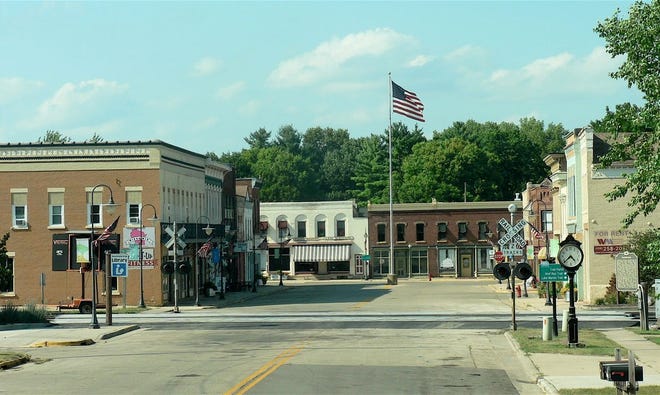Visiting Mazomanie is like going 100 years back in time

My first real visit to Mazomanie, Wisconsin was in the very early days of this column (1992?) when I interviewed Joel Schultz, who was leasing and running the Mazomanie feed mill. I remember it was an old country feed mill that had seen better days, but was on a downhill slope as dairy farmers were moving to commodity feeding while their herds grew in size. Schultz left the mill soon after and began working at another country feed mill at Deansville, near Marshall, and the mill was vacant for a short time.
My wife and I returned to Mazomanie many times to visit that old feed mill which had morphed into "The Old Feed Mill," a high quality restaurant/supper club after extensive remodeling by Dan Viste, a Madison hydrogeologist and former president of Warzyn Engineering in Madison, and his wife Nancy, a former medical technician at the University of Wisconsin-Madison.


From feed to food
The Vistes had bought the old mill and remade it into the now well-known and popular The Old Feed Mill restaurant. The couple began serving food in October 1995 and are now celebrating their 25th year in operation.
Why leave secure professions to buy an old feed mill in Mazomanie? "Some would call it lunacy," Dan says. "I guess we were looking for a change and saw the village as a future tourism center."
Dan Viste soon became deeply involved with others in the community in efforts to reconstruct the rural village's downtown that had sort of fallen on hard times over the years. The Vistes started buying property there in 1992, and at one time owned nine buildings, restoring them and several others. Viste says one of the major efforts was the construction and restoration of what was called the Broadhead Street Redevelopment Project. Four historic structures were renovated and restored with a conversion to affordable housing and retail units using historic and affordable housing tax credits.

Built in 1863
"The brick building we restored dates back to 1863. We had to crib the frail brick structure to keep the front wall from collapsing," he explains. "The cornice structure, eyebrow, was set on the street in front of the Whistlestop Cafe, which I had previously restored." It was then moved to another building down the street where it was restored. It was placed back on the structure in the fall of 2005. The entire renovation was completed in less than 9 months, Viste says.

Back in time
It's like a step back in time when driving through downtown's Brodhead Street, with its brick and stone storefronts, plus pillars and railings intact from the mid-1800s. Running through town are the railroad tracks that spurred the founding of this village in 1855, along with the flour mill and railroad depot built two years later.
Alongside the tracks, a huge promenade was constructed, offering space for outdoor events including the popular Gandy Dancer Festival featuring bluegrass music, which was canceled this year because of the coronavirus.

2009, a slow down
The village, with 33 buildings on the National Register of Historic Places and a population of just 1,600, was on its way to rejuvenation – until the recession of 2009 slowed the flow of money from grants and gifts. Major reconstruction efforts came to a standstill, although a performing arts and band shell was completed recently, something Viste sees as major factor for future downtown events.

Still, a great future
Viste and others in the community still see a glowing future for the village because of its location, which is a tourism promoter's dream in the center of tourism heaven: the cities of Madison, Wisconsin Dells and Spring Green and popular Taliesin (the 800-acre home estate of architect Frank Lloyd Wright) and the American Players Theater are all nearby.
"The redevelopment of downtown Mazomanie took a step back after the recession of 2009, but recently we can see signs of progress," Viste says. "The Westland Promenade is now a mature downtown park setting with shelters and trees, and opposite the tracks is a new outdoor stage designed by the Frank Lloyd Wright School of Architecture as a gift to the village. We believe this improvement, along with two new beautiful walking and biking trails that originate at the Promenade will help bring new life."

Sugarland
Today, the Vistes own just two buildings in Mazomanie, including The Old Feed Mill. But for the last seven years, they have been involved in the development of Sugarland – a national wedding destination just a couple miles west of Mazomanie on a rural road.
Sugarland, an 1800s dairy barn and farmhouse, is named after Bobby "Sugar" Hinds, the former UW-Madison boxer and later jump rope king. Hinds and his wife, Joy, bought the property as a rural retreat, but with Viste's advice and assistance, the property has become a desirable wedding site for couples near and far. In union with the Vistes and The Old Feed Mill, the complex has facilities for an outdoor wedding and meals desired.
Downtown Mazomanie will ultimately grow and become a commuter and tourism center, but for now, it's small-town USA set in about 1910. In other towns and villages, the old original buildings have been torn down or covered over with flashy siding and signs, but here in Mazomanie they still stand. I'm fascinated by looking at and imagining what life here was like with horses, wagons and Model T's with families shopping on Brodhead Street in Mazomanie a hundred years ago ... and so will you.
John F. Oncken is owner of Oncken Communications. He can be reached at 608-837-7406 or e-mail him at jfodairy2@gmail.com.